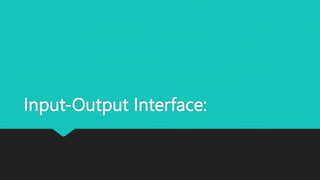
Presentation dfa.pptx
- 2. Functions of Input-Output Interface: 1. It is used to synchronize the operating speed of CPU with respect to input-output devices. 2. It selects the input-output device which is appropriate for the interpretation of the input-output device. 3. It is capable of providing signals like control and timing signals. 4. In this data buffering can be possible through data bus. 5. There are various error detectors. 6. It converts serial data into parallel data and vice-versa. 7. It also convert digital data into analog signal and vice-versa.
- 3. Asynchronous Data Transfer: The internal operations in an individual unit of a digital system are synchronized using clock pulse. It means clock pulse is given to all registers within a unit. And all data transfer among internal registers occurs simultaneously during the occurrence of the clock pulse. Now, suppose any two units of a digital system are designed independently, such as CPU and I/O interface. If the registers in the I/O interface share a common clock with CPU registers, then transfer between the two units is said to be synchronous. But in most cases, the internal timing in each unit is independent of each other, so each uses its private clock for its internal registers. In this case, the two units are said to be asynchronous to each other, and if data transfer occurs between them, this data transfer is called Asynchronous Data Transfer. But, the Asynchronous Data Transfer between two independent units requires that control signals be transmitted between the communicating units so that the time can be indicated at which they send data. These two methods can achieve this asynchronous way of data transfer:
- 4. Asynchronous Data Transfer Methods The asynchronous data transfer between two independent units requires that control signals be transmitted between the communicating units to indicate when they send the data. Thus, the two methods can achieve the asynchronous way of data transfer.
- 5. Strobe Control Method The Strobe Control method of asynchronous data transfer employs a single control line to time each transfer. This control line is also known as a strobe, and it may be achieved either by source or destination, depending on which initiate the transfer. . Source initiated strobe: In the below block diagram, you can see that strobe is initiated by source, and as show in the timing diagram, the source unit firs After a brief delay to ensure that the data resolve to a stable value, the source activates a strobe pulse. The information on the data bus and strobe control signal remains in the active state for a sufficient time to allow the destination unit to receive the data. The destination unit uses a falling edge of strobe control to transfer the contents of a data bus to one of its internal registers. The source removes the data from the data bus after it disables its strobe pulse. Thus, new valid data will be available only after the strobe is enabled again.In this case, the strobe may be a memory-write control signal from the CPU to a mt places the
- 6. Handshaking Method The strobe method has the disadvantage that the source unit that initiates the transfer has no way of knowing whether the destination has received the data that was placed in the bus. Similarly, a destination unit that initiates the transfer has no way of knowing whether the source unit has placed data on the bus. So this problem is solved by the handshaking method. The handshaking method introduces a second control signal line that replays the unit that initiates the transfer. In this method, one control line is in the same direction as the data flow in the bus from the source to the destination. The source unit uses it to inform the destination unit whether there are valid data in the bus. The other control line is in the other direction from the destination to the source. This is because the destination unit uses it to inform the source whether it can accept data. And in it also, the sequence of control depends on the unit that initiates the transfer. So it means the sequence of control depends on whether the transfer is initiated by source and destination.